Delineating the Regional Economic Geography of China by the Approach of Community Detection
Abstract
:1. Introduction
2. Literature Review
3. Data and Methods
3.1. Car-hailing Commuting Dataset
3.2. Method
3.2.1. Identification using the Method of Community Detection
3.2.2. Algorithms Used for Regional Delineation
4. Results
4.1. The Overall Visualized Commute Landscape
4.2. Regionalization by Louvain
4.3. Regionalization by Combo
4.4. Comparing Larger FRs Tested by Louvain and Combo with Policy-Defined Regions
5. Discussion
6. Conclusions
Author Contributions
Funding
Acknowledgments
Conflicts of Interest
References
- Weber, C. Urban agglomeration delimitation using remote sensing data. In Remote Sensing and Urban Analysis: GISDATA 9; Donnay, J.P., Barnsley, M.J., Longley, P.A., Eds.; Taylor & Francis: London, UK; New York, NY, USA, 2003; pp. 131–146. [Google Scholar]
- Krugman, P. What’s new about the new economic geography? Oxf. Rev. Econ. Policy 1998, 14, 7–17. [Google Scholar] [CrossRef]
- Fujita, M.; Krugman, P. The new economic geography: Past, present and the future. In Fifty Years of Regional Science; Springer: Berlin/Heidelberg, Germany, 2004; pp. 139–164. [Google Scholar]
- Duranton, G.; Puga, D. Micro-Foundations of urban agglomeration economies. In Handbook of Regional and Urban Economics; Elsevier: Amsterdam, The Netherlands, 2004; pp. 2063–2117. [Google Scholar]
- Uchida, H.; Nelson, A. Agglomeration Index: Towards a New Measure of Urban Concentration. 2009. Available online: https://openknowledge.worldbank.org/bitstream/handle/10986/9039/WDR2009_0008.pdf?sequence=1 (accessed on 20 August 2019).
- Fang, C.; Yu, D. Urban agglomeration: An evolving concept of an emerging phenomenon. Landsc. Urban Plan. 2017, 162, 126–136. [Google Scholar] [CrossRef]
- Gottmann, J. Megalopolis or the urbanization of the northeastern seaboard. Econ. Geogr. 1957, 33, 189–200. [Google Scholar] [CrossRef]
- Geddes, P. Cities in Evolution: An Introduction to the Town Planning Movement and to the Study of Civics; Ernest Benn: London, UK, 1968. [Google Scholar]
- Gavin, J. Southeast Asian urbanization and the growth of mega-urban regions. J. Popul. Res. 2002, 19, 119–136. [Google Scholar]
- Scott, A.J.; Scott, A.J. Global City-Regions; Oxford University Press: Oxford, UK, 2001; pp. 11–30. [Google Scholar]
- Hall, P.G.; Pain, K. (Eds.) The Polycentric Metropolis: Learning from Mega-City Regions in Europe; Routledge: London, UK, 2006. [Google Scholar]
- Neuman, M.; Hull, A. The futures of the city region. Reg. Stud. 2009, 43, 777–787. [Google Scholar] [CrossRef]
- Florida, R.; Gulden, T.; Mellander, C. The rise of the mega-region. Camb. J. Reg. Econ. Soc. 2008, 1, 459–476. [Google Scholar] [CrossRef]
- Innes, J.E.; Booher, D.E.; Di Vittorio, S. Strategies for megaregion governance: Collaborative dialogue, networks, and self-organization. J. Am. Plan. Assoc. 2010, 77, 55–67. [Google Scholar] [CrossRef]
- United Nations. Department of Economic and Social Affairs, Population Division. In World Population Prospects 2019; United Nations: New York, NY, USA, 2019; Available online: https://population.un.org/wpp/Publications/Files/WPP2019_Highlights.pdf (accessed on 20 August 2019).
- Chen, L.; Xue, L. Global production networks and the upgrading of China’s integrated circuit industry. China World Econ. 2010, 18, 109–126. [Google Scholar] [CrossRef]
- CPC; The State Council. Opinions on Establishing a More Effective Regional Coordination and Development Mechanism. Beijing, China, Press Release; 2018. Available online: http://www.gov.cn/zhengce/2018-11/29/content_5344537.htm (accessed on 26 August 2019).
- Christaller, W. Die Zentralen Orte in Süddeutschland: Eine Ökonomisch-Geographische Untersuchung Über Die Gesetzmässigkeit Der Verbreitung Und Entwicklung Der Siedlungen Mit Städtischen Funktionen; Gustav Fisher Verlag: Jena, Germany, 1933. [Google Scholar]
- Lösch, A. Die Räumliche Ordnung Der Wirtschaft; Verlag von Gustav Fischer: Stuttgart, Germany, 1944. [Google Scholar]
- Castells, M. The Rise of the Network Society; Blackwell: Cambridge, MA, USA, 1996. [Google Scholar]
- Taylor, P.J. World City Network: A Global Urban Analysis; Routledge: London, UK; New York, NY, USA, 2004. [Google Scholar]
- Karlsson, C.; Olsson, M. The identification of functional regions: Theory, methods, and applications. Ann. Reg. Sci. 2006, 40, 1–18. [Google Scholar] [CrossRef]
- Khanna, P. Connectography: Mapping the Future of Global Civilization; Random House: New York, NY, USA, 2016. [Google Scholar]
- Duranton, G. Delineating metropolitan areas: Measuring spatial labour market networks through commuting patterns. In The Economics of Interfirm Networks; Watanabe, T., Uesugi, I., Ono, A., Eds.; Springer: Tokyo, Japan, 2015. [Google Scholar]
- Nelson, G.D.; Rae, A. An economic geography of the United States: From commutes to megaregions. PLoS ONE 2016, 11, e0166083. [Google Scholar] [CrossRef]
- De Meo, P.; Ferrara, E.; Fiumara, G.; Provetti, A. Generalized louvain method for community detection in large networks. In Proceedings of the 2011 11th International Conference on Intelligent Systems Design and Applications, ISDA 2011, Córdoba, Spain, 22–24 November 2011; pp. 88–93. [Google Scholar]
- Sobolevsky, S.; Campari, R.; Belyi, A.; Ratti, C. General optimization technique for high-quality community detection in complex networks. Phys. Rev. E 2014, 90, 012811. [Google Scholar] [CrossRef] [PubMed] [Green Version]
- Sng, T.H.; Chia, P.Z.; Feng, C.-C.; Wang, Y.-C. Are China’s provincial boundaries misaligned? Appl. Geogr. 2018, 98, 52–65. [Google Scholar] [CrossRef]
- Hartshorne, R. The nature of geography: A critical survey of current thought in the light of past. Ann. Assoc. Am. Geogr. 1939, 29, 413–658. [Google Scholar] [CrossRef]
- Batty, M. The New Science of Cities; The MIT Press: Cambridge, MA, USA, 2013. [Google Scholar]
- Bridge, G. Mapping the terrain of time-space compression: Power networks in everyday life. Environ. Plan. D-Soc. Space 1997, 15, 611–626. [Google Scholar] [CrossRef]
- Kivisto, P. Time-space compression. In Wiley-Blackwell Encyclopedia of Globalization; Wiley-Blackwell: New York, NY, USA, 2012. [Google Scholar]
- Castells, M. The Information City: Information Technology, Economic Restructuring, and the Urban-Regional Progress; Blackwell: Oxford, UK; Cambridge, MA, USA, 1989. [Google Scholar]
- Zook, M.A. Old hierarchies or new networks of centrality? The global geography of the Internet content market. Am. Behav. Sci. 2001, 44, 1679–1696. [Google Scholar] [CrossRef]
- Rietveld, P.; Vickerman, R. Transport in regional science: The ‘death of distance’ is premature. Pap. Reg. Sci. 2004, 83, 229–248. [Google Scholar] [CrossRef]
- Pflieger, G.; Rozenblat, C. Urban networks and network theory: The city as the connector of multiple networks. Urban Stud. 2010, 47, 2723–2735. [Google Scholar] [CrossRef]
- Berry, B.J.L. Cities as systems within systems of cities. Pap. Reg. Sci. 1964, 13, 147–163. [Google Scholar] [CrossRef]
- Taylor, P.J.; Evans, D.M.; Pain, K. The UK space economy as practiced by advanced producer service firms: Identifying two distinctive polycentric city-regional processes in contemporary Britain. Int. J. Urban Reg. Res. 2009, 33, 700–718. [Google Scholar] [CrossRef]
- Alderson, A.S.; Beckfield, J.; Sprague-Jones, J. Intercity Relations and Globalization: The Evolution of the Global Urban Hierarchy, 1981–2007. Urban Stud. 2010, 47, 1899–1923. [Google Scholar] [CrossRef]
- Goei, B.D.; Burger, M.J.; Oort, F.G.V.; Kitson, M. Functional Polycentrism and Urban Network Development in the Greater South East, United Kingdom: Evidence from Commuting Patterns, 1981–2001. Reg. Stud. 2010, 44, 1149–1170. [Google Scholar] [CrossRef]
- Short, J.R.; Kim, Y.; Kuus, M.; Wells, H. The Dirty Little Secret of World City Research: Data Problems in Comparative Analysis. Int. J. Urban Reg. Res. 1996, 20, 697–717. [Google Scholar] [CrossRef]
- Lazer, D.; Pentland, A.S.; Adamic, L.; Aral, S.; Barabasi, A.-L.; Brewer, D.; Christakis, N.; Contractor, N.; Fowler, J.; Gutmann, M.; et al. Life in the network: The coming age of computational social science. Science 2009, 323, 721–723. [Google Scholar] [CrossRef] [PubMed]
- Sobolevsky, S.; Szell, M.; Campari, R.; Couronne, T.; Smoreda, Z.; Ratti, C. Delineating geographical regions with networks of human interactions in an extensive set of countries. PLoS ONE 2013, 8, e81707. [Google Scholar] [CrossRef] [PubMed]
- Ratti, C.; Frenchman, D.; Pulselli, R.M.; Williams, S. Mobile landscape: Using location data from cell phones for urban analysis. Env. Plan. B-Plan. Des. 2006, 33, 727. [Google Scholar] [CrossRef]
- González, M.; Hidalgo, C.; Barabási, A.L. Understanding individual human mobility patterns. Nature 2008, 453, 779–782. [Google Scholar] [CrossRef] [PubMed]
- Liu, Y.; Kang, C.; Gao, S.; Xiao, Y.; Tian, Y. Understanding intra-urban trip patterns from taxi trajectory data. J. Geogr. Syst. 2012, 14, 463–483. [Google Scholar] [CrossRef]
- Liu, Y.; Sui, Z.W.; Kang, C.G.; Gao, Y. Uncovering patterns of inter-urban trip and spatial interaction from social media check-in data. PLoS ONE 2014, 9, e86026. [Google Scholar] [CrossRef]
- Long, Y.; Thill, J.C. Combining smart card data and household travel survey to analyze jobs–housing relationships in Beijing. Comput. Environ. Urban Syst. 2015, 53, 19–35. [Google Scholar] [CrossRef]
- Tang, J.J.; Liu, F.; Wang, Y.; Wang, H. Uncovering urban human mobility from large scale taxi GPS data. Phys. A Stat. Mech. Appl. 2015, 438, 140–153. [Google Scholar] [CrossRef]
- Huang, W.; Li, S.N. Understanding human activity patterns based on space-time-semantics. ISPRS-J. Photogramm. Remote Sens. 2016, 121, 1–10. [Google Scholar] [CrossRef]
- Ilieva, R.T.; McPhearson, T. Social-media data for urban sustainability. Nat. Sustain. 2018, 1, 553. [Google Scholar] [CrossRef]
- Marti, P.; Serrano-Estrada, L.; Nolasco-Cirugeda, A. Social media data: Challenges, opportunities and limitations in urban studies. Comput. Environ. Urban Syst. 2019, 74, 161–174. [Google Scholar] [CrossRef]
- Ratti, C.; Sobolevsky, S.; Calabrese, F.; Andris, C.; Reades, J.; Martino, M.; Claxton, R.; Strogatz, S.H. Redrawing the map of Great Britain from a network of human interactions. PLoS ONE 2010, 5, e14248. [Google Scholar] [CrossRef] [PubMed]
- Kallus, Z.; Barankai, N.; Szüle, J.; Vattay, G. Spatial fingerprints of community structure in human interaction network for an extensive set of large-scale regions. PLoS ONE 2015, 10, e0126713. [Google Scholar] [CrossRef] [PubMed]
- United States Census Bureau. History: Metropolitan Areas. U.S. Census Bureau, 31 March 2014. Available online: http://www.census.gov/history/www/programs/geography/metropolitan_areas.html (accessed on 17 June 2015).
- European Spatial Planning Observation Network (ESPON). Study on Urban Functions. ESPON Project 1.4.3. 2007. Available online: https://www.espon.eu/sites/default/files/attachments/fr-1.4.3_April2007-final.pdf (accessed on 17 June 2015).
- OECD. Redefining Urban: A New Way to Measure Metropolitan Areas. OECD Publishing, 2012. Available online: http://dx.doi.org/10.1787/9789264174108-en (accessed on 17 June 2015).
- Gu, C. A preliminary study on the division of urban economic regions in China. Acta Geogr. Sin. 1991, 46, 129–141. (In Chinese) [Google Scholar]
- Ning, Y. Definition of Chinese metropolitan areas and large urban agglomerations: Role of large urban agglomerations in regional development. Sci. Geogr. Sin. 2011, 31, 257–263. (In Chinese) [Google Scholar]
- Zhou, Y.; Zhang, L. China’s urban economic region in the open context. Acta Geogr. Sin. 2003, 58, 271–284. (In Chinese) [Google Scholar]
- Zhang, Q.; Hu, Y.; Liu, J.; Liu, Y.; Ren, W.; Li, J. A quantitative assessment of the distribution and extent of urban clusters in China. J. Geogr. Sci. 2012, 22, 137–151. [Google Scholar] [CrossRef]
- Ma, Y.; Xue, F. Deciphering the spatial structures of city networks in the economic zone of the West Side of the Taiwan Strait through the lens of functional and innovation networks. Sustainability 2019, 11, 2975. [Google Scholar] [CrossRef]
- Bollobás, B. Modern Graph Theory; Springer Science & Business Media: Berlin/Heidelberg, Germany, 2013; Volume 184. [Google Scholar]
- Lancichinetti, A.; Fortunato, S.; Radicchi, F. Benchmark graphs for testing community detection algorithms. Phys. Rev. E 2008, 78, 046110. [Google Scholar] [CrossRef] [PubMed] [Green Version]
- Girvan, M.; Newman, M.E. Community structure in social and biological networks. Proc. Natl. Acad. Sci. USA 2002, 99, 7821–7826. [Google Scholar] [CrossRef] [PubMed] [Green Version]
- Pereira-Leal, J.B.; Enright, A.J.; Ouzounis, C.A. Detection of functional modules from protein interaction networks. Proteins 2004, 54, 49–57. [Google Scholar] [CrossRef] [PubMed]
- Manley, E. Identifying functional urban regions within traffic flow. Reg. Stud. Reg. Sci. 2014, 1, 40–42. [Google Scholar] [CrossRef]
- Newman, M.E. The structure and function of complex networks. SIAM Rev. 2003, 45, 167–256. [Google Scholar] [CrossRef]
- Fortunato, S. Community detection in graphs. Phys. Rep. 2010, 486, 75–174. [Google Scholar] [CrossRef]
- Clauset, A.; Newman, M.E.; Moore, C. Finding community structure in very large networks. Phys. Rev. E 2004, 70, 066111. [Google Scholar] [CrossRef] [Green Version]
- Blondel, V.D.; Guillaume, J.L.; Lambiotte, R.; Lefebvre, E. Fast unfolding of communities in large networks. J. Stat. Mech. Theory Exp. 2008, 2008, P10008. [Google Scholar] [CrossRef] [Green Version]
- De Montis, A.; Cashili, S.; Chessa, A. Commuter networks and community detection: A method for planning sub regional areas. Eur. Phys. J.-Spec. Top. 2013, 215, 75–91. [Google Scholar] [CrossRef]
- Betzel, R.F.; Griffa, A.; Avena-Koenigsberger, A.; Goñi, J.; Thiran, J.P.; Hagmann, P.; Sporns, O. Multi-scale community organization of the human structural connectome and its relationship with resting-state functional connectivity. Netw. Sci. 2013, 1, 353–373. [Google Scholar] [CrossRef] [Green Version]
- Hong, Q.; Kim, S.; Cheung, S.C.; Bird, C. Understanding a developer social network and its evolution. In Proceedings of the 2011 27th IEEE international conference on software maintenance (ICSM), Williamsburg, VA, USA, 25–30 September 2011; pp. 323–332. [Google Scholar]
- National Development and Reform Commission (NDRC). People Republic of China. The Guidance of Cultivate and Development the Modern Metropolitan Circles; NDRC: Beijing, China, 2019. Available online: http://www.ndrc.gov.cn/gzdt/201902/t20190221_928325.html?from=timeline&isappinstalled=0 (accessed on 16 October 2019).

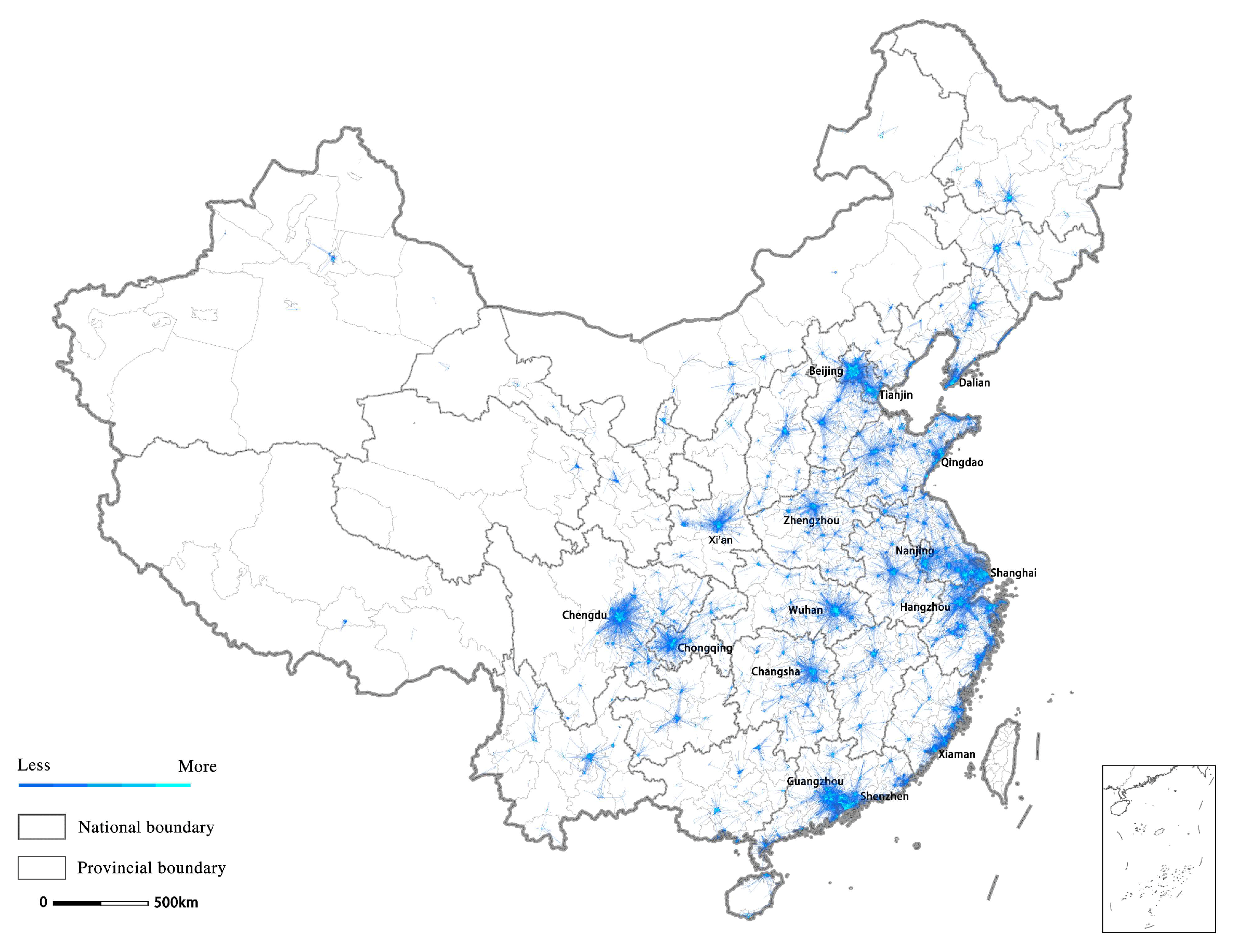
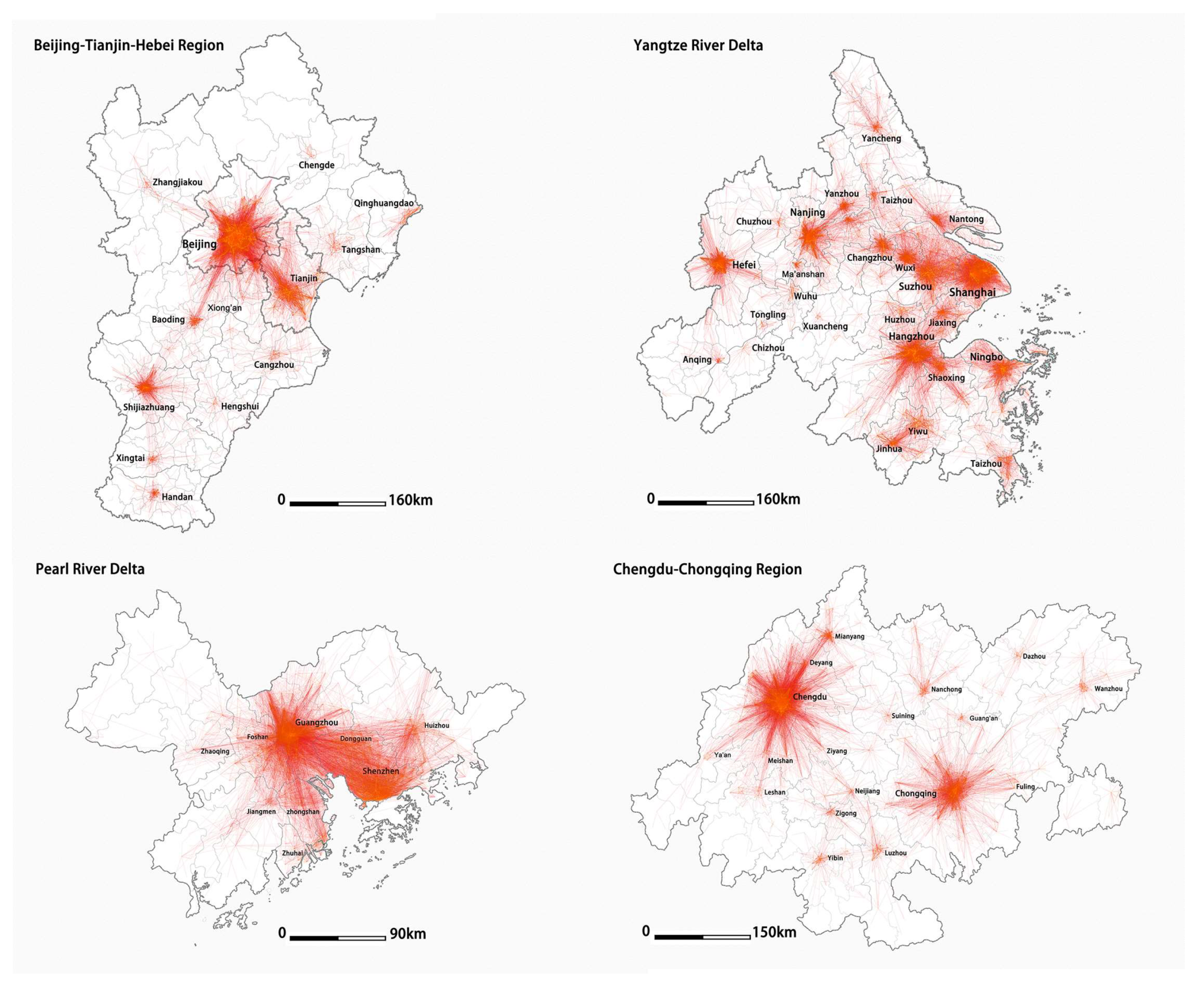
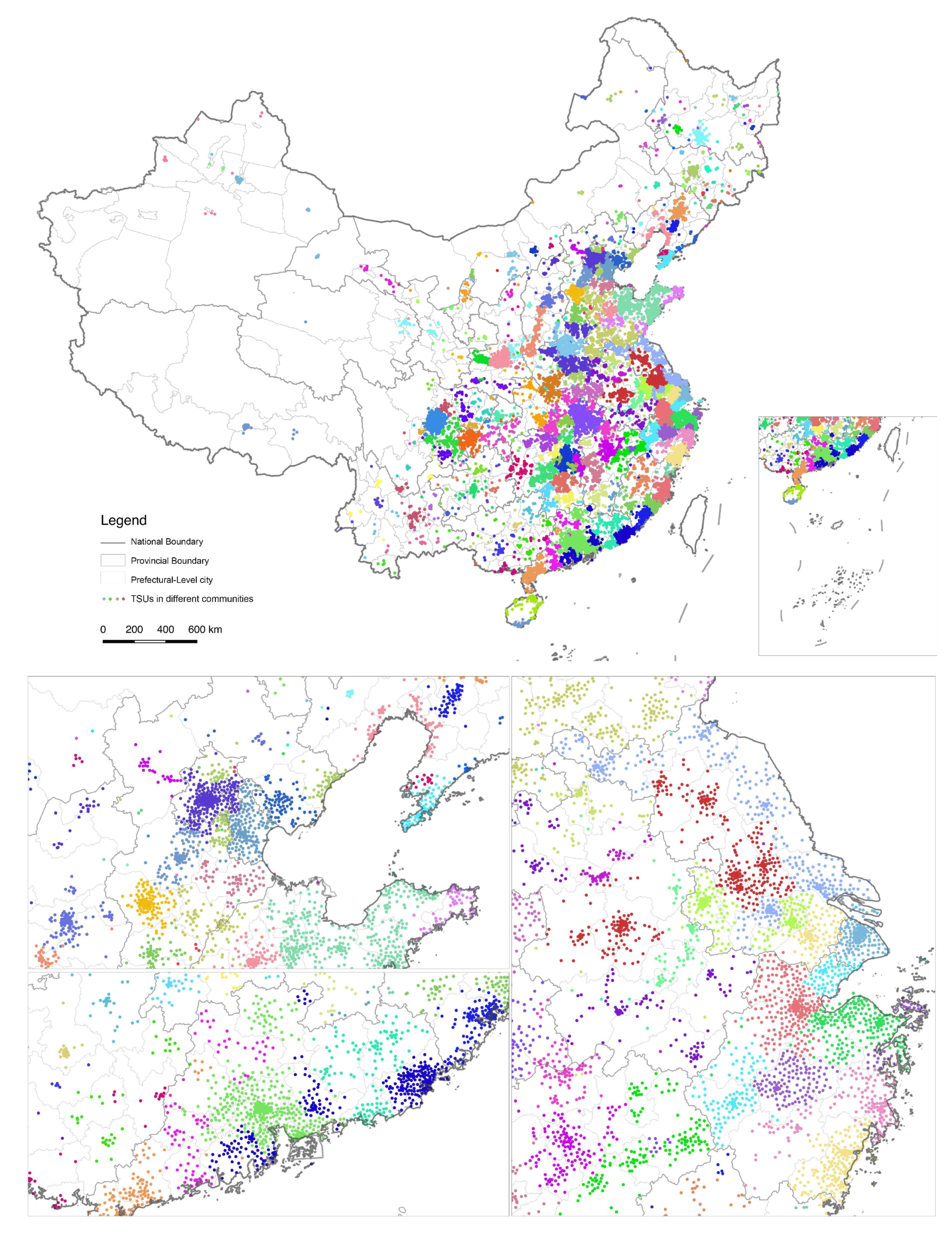

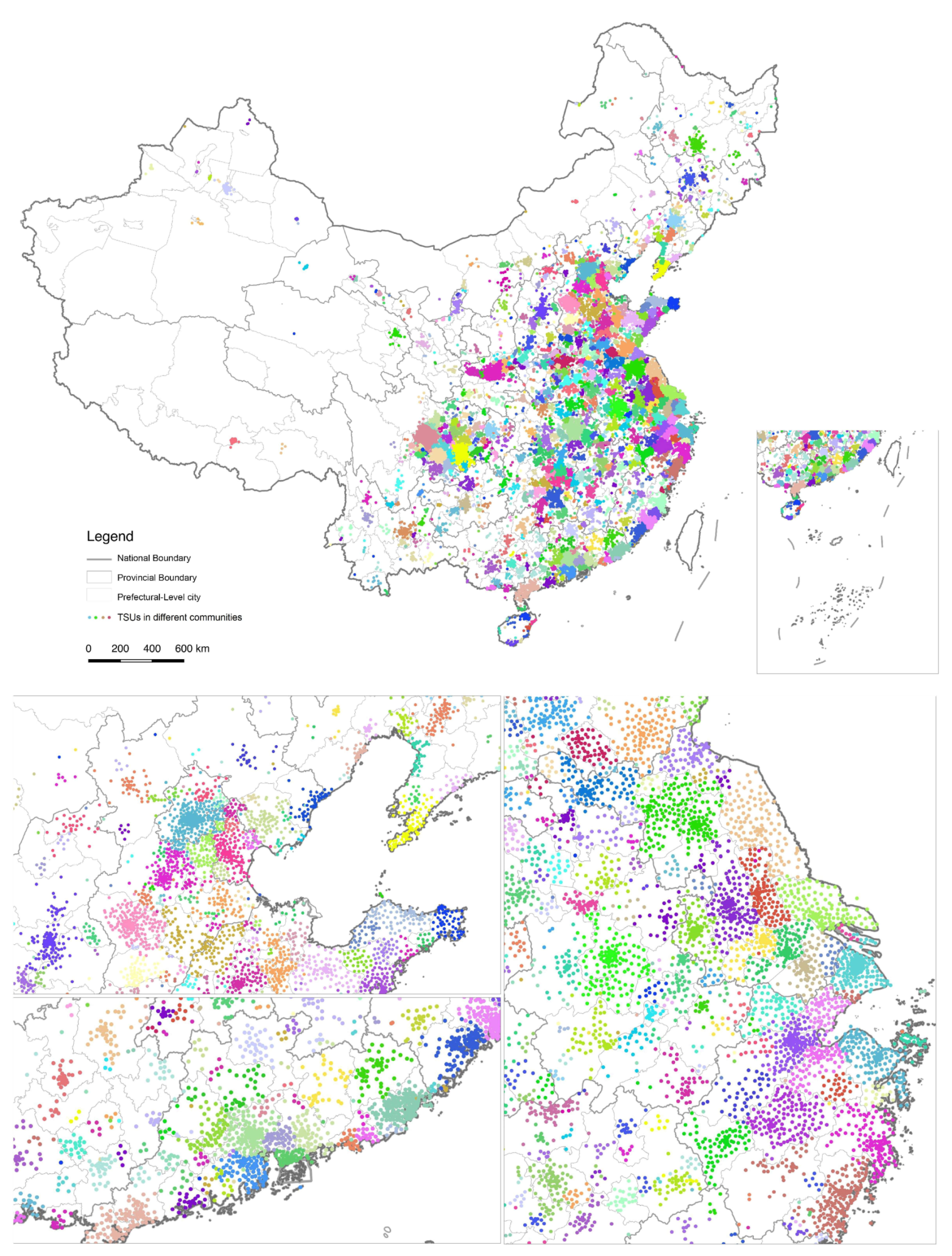

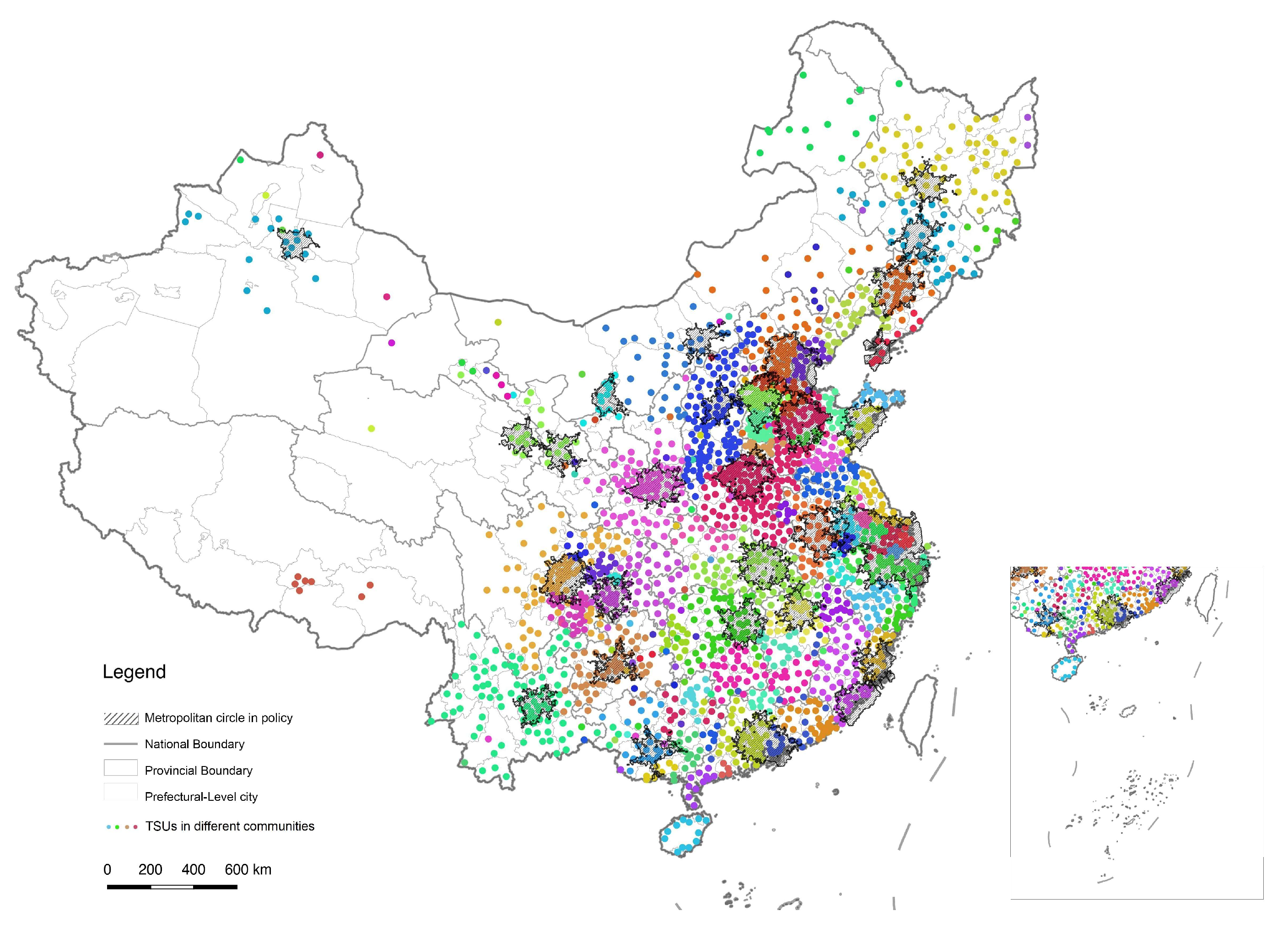
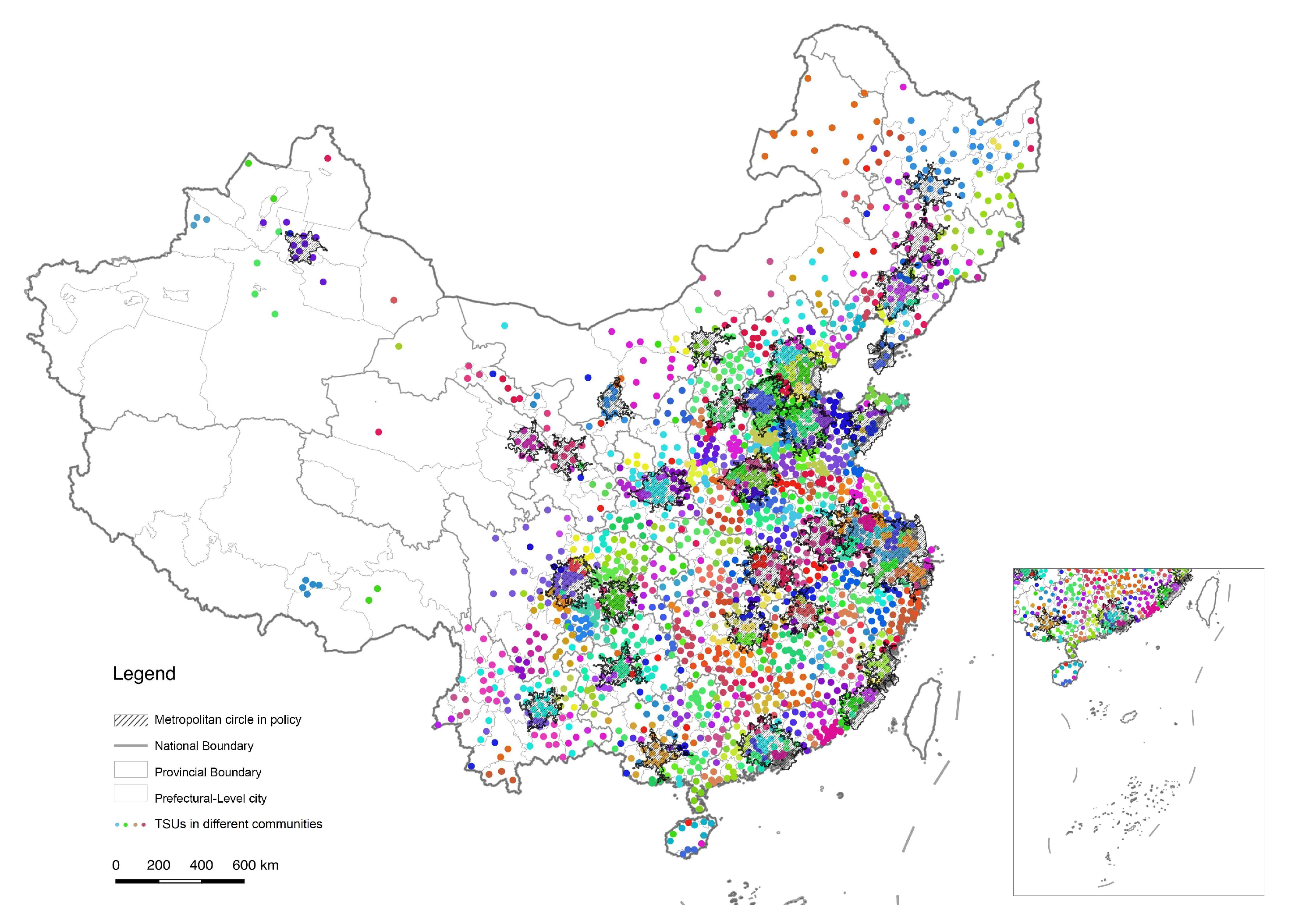
| Parameters/Resolution | 0.1 | 1 | 3 | 5 | 7 | 11 | 20 | 50 | 100 |
|---|---|---|---|---|---|---|---|---|---|
| Number of Communities | 762 | 614 | 569 | 556 | 548 | 542 | 531 | 520 | 511 |
| Modularity with Resolution | 0.074 | 0.958 | 2.954 | 4.951 | 6.949 | 10.944 | 19.94 | 49.943 | 99.926 |
| Modularity | 0.882 | 0.958 | 0.956 | 0.956 | 0.955 | 0.952 | 0.944 | 0.943 | 0.941 |
© 2019 by the authors. Licensee MDPI, Basel, Switzerland. This article is an open access article distributed under the terms and conditions of the Creative Commons Attribution (CC BY) license (http://creativecommons.org/licenses/by/4.0/).
Share and Cite
Wu, K.; Tang, J.; Long, Y. Delineating the Regional Economic Geography of China by the Approach of Community Detection. Sustainability 2019, 11, 6053. https://doi.org/10.3390/su11216053
Wu K, Tang J, Long Y. Delineating the Regional Economic Geography of China by the Approach of Community Detection. Sustainability. 2019; 11(21):6053. https://doi.org/10.3390/su11216053
Chicago/Turabian StyleWu, Kang, Jingxian Tang, and Ying Long. 2019. "Delineating the Regional Economic Geography of China by the Approach of Community Detection" Sustainability 11, no. 21: 6053. https://doi.org/10.3390/su11216053
APA StyleWu, K., Tang, J., & Long, Y. (2019). Delineating the Regional Economic Geography of China by the Approach of Community Detection. Sustainability, 11(21), 6053. https://doi.org/10.3390/su11216053






